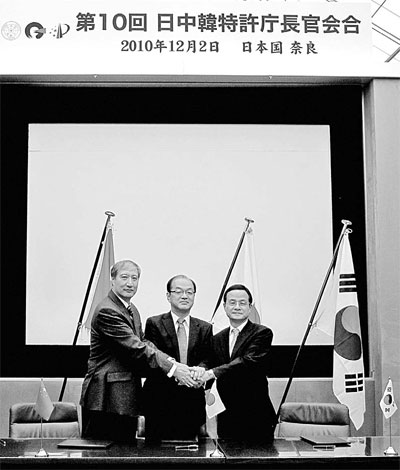Inforgraphic
SIPO head: Setting the record straight
Updated: 2010-12-29 16:14
By Tian Lipu (China Daily)
|
 |
|
SIPO Commissioner Tian Lipu (left) shakes hands with counterparts from Japan and South Korea in early December after signing an intellectual property protection agreement in Nara, Japan. [Photo / Provided to China Daily] |
Commissioner of the State Intellectual Property Office
Recent foreign media coverage of China's intellectual property is full of negative information. This gives me the impression that if you want to get attention in Western countries, just blame China - and if you want to attract even more attention, accuse its intellectual property protection.
On September 23, Japan's Sankei Shinbun newspaper reported that the US Congress held a hearing to protest China's "fake products".
On October 4, Reuters reported that US Under Secretary of State Robert Hormats called on the European Union to join the US and force China to change its policies on intellectual property and foreign investment.
China Trap, a recent bestseller in Germany, warns European enterprises not to fall into a huge "China trap" when investing in the nation.
In addition, some politicians, enterprises and social organizations are also wagging their fingers at what China has done to protect the intellectual property.
These reports cause me confusion and unease, so I would like to pass along truths and facts that are rarely seen in Western media to help readers have a comprehensive picture about China's intellectual property protection.
I am Commissioner of the State Intellectual Property Office of the People's Republic of China (SIPO) and have been working in the intellectual property area for more than 30 years.
Curiosity and haste
I can still recall how I entered the area by chance at the end of the 1970s. I attribute my decision at that time to the curiosity of a graduate student for unknown things and the haste of a young man.
|
||||
However, I feel very lucky to have entered the area, which was totally new to China then, and have since worked in the field.
At that time - save a few score of people - the Chinese population of 800 million had zero knowledge about intellectual property, myself included.
Further, people were not used to linking knowledge to property. On the contrary, people at that time generally believed that knowledge should be spread and used freely and for free - knowledge should be shared by the entire society and even the world, and charging was considered as something unimaginable.
For this reason, though the term "intellectual property" was translated into Chinese in the 1970s, it was not included in the Xinhua Dictionary - the nation's most common language reference resource used by hundreds of millions of Chinese students - until 2000.
Driven by reform and opening up, the Chinese government decided to implement a modern intellectual property system, but the legislative process was very prolonged. The debate was heated.
E-paper

Ear We Go
China and the world set to embrace the merciful, peaceful year of rabbit
Preview of the coming issue
Carrefour finds the going tough in China
Maid to Order
Specials

Mysteries written in blood
Historical records and Caucasian features of locals suggest link with Roman Empire.

Winning Charm
Coastal Yantai banks on little things that matter to grow

New rules to hit property market
The State Council launched a new round of measures to rein in property prices.




